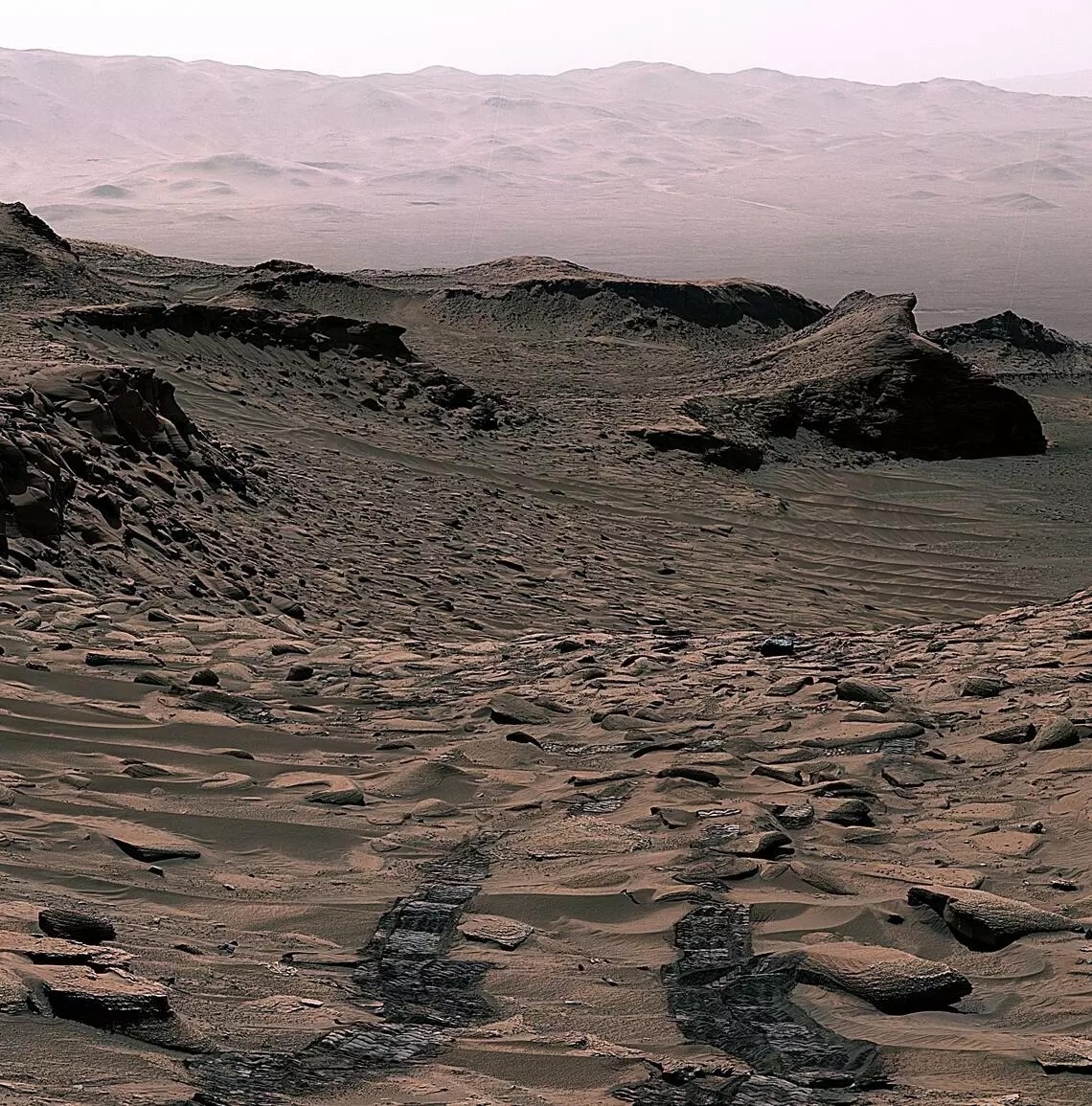20.04.2025
UCalgary scientist Ben Tutolo lead author in groundbreaking study published in the journal Science

A photo-mosaic taken by the Curiosity Rover on April 30, 2023 at the Ubajara drill site in Gale Crater, Mars. Rock powder samples drilled here contained siderite, an iron carbonate mineral. Rover tracks in the foreground are 40 cm wide.
NASA Jet Propulsion Laboratory-Caltech/Malin Space Science Systems
It wasn’t long after Ben Tutolo started as a participating scientist on NASA’s Mars Science Laboratory Curiosity Rover team that he started to understand just how much information was being collected on the red planet.
“You are getting blasted with data all the time, so you have to be able to take a step back whenever something really compelling comes down the line,” says Dr. Tutolo, PhD, associate professor with the Department of Earth, Energy, and Environment in the Faculty of Science.
He took a step back last year to answer a longstanding question: Why are there no carbonates on Mars?
“If any of our models about atmospheric warming are correct, we know that you must have had a large amount of CO2 on ancient Mars to stabilize liquid water. Which means there should have been interactions between the CO2 and the basalts that make up the planet. You should have carbonate minerals on Mars,” says Tutolo. “But nobody has ever been able to find them at the levels we would expect.”
Until now.
Curiosity rover finds ‘large carbon deposits’ on Mars
Research from NASA’s Curiosity rover, published this week in the prestigious journal Science, has found evidence of a carbon cycle on ancient Mars.
The paper reveals that data from three of Curiosity’s drill sites had siderite, an iron carbonate material, within sulfate-rich layers of Mount Sharp in Gale Crater.
“The discovery of large carbon deposits in Gale Crater represents both a surprising and important breakthrough in our understanding of the geologic and atmospheric evolution of Mars,” says Tutolo, a geochemist who’s the lead author on the paper.
Reaching the strata, he says, was a long-term goal of the Mars Science Laboratory mission.
“The abundance of highly soluble salts in these rocks and similar deposits mapped over much of Mars has been used as evidence of the ‘great drying’ of Mars during its dramatic shift from a warm and wet early Mars to its current, cold and dry state,” explains Tutolo.
Sedimentary carbonate has long been predicted to have formed under the CO2-rich ancient Martian atmosphere, but Tutolo says identifications had previously been sparse.
NASA’s Curiosity rover landed on Mars on Aug. 5, 2012, and has travelled more than 34 kilometres on the surface.
Curiosity drills three to four centimetres down into the subsurface to study the chemical and mineral makeup.
“Drilling though the layered Martian surface is like going through a history book,” Dr. Thomas Bristow, PhD, a research scientist at NASA Ames and a co-author on the paper, says in a statement.
The discovery of carbonate suggests that the atmosphere contained enough carbon dioxide to support liquid water existing on the planet’s surface. As the atmosphere thinned, the carbon dioxide transformed into rock form.
NASA says future missions and analysis of other sulfate-rich areas on Mars could confirm the findings and help to better understand the planet’s early history and how it transformed as its atmosphere was lost.
Life on Mars?
Scientists are ultimately trying to determine whether Mars was ever capable of supporting life – and the latest discovery brings them closer to an answer.
“It tells us that the planet was habitable and that the models for habitability are correct,” says Tutolo.
“The broader implications are that the planet was habitable up until this time, but then, as the CO2 that had been warming the planet started to precipitate as siderite, it likely impacted Mars’ ability to stay warm,” he explains.
“The question looking forward is how much of this CO2 from the atmosphere was actually sequestered? Was that potentially a reason we began to lose habitability?”
The research, he adds, fits with his ongoing work on Earth – trying to turn anthropogenic CO2 into carbonates as a climate change solution.
“Learning about the mechanisms of making these minerals on Mars helps us to better understand how we can do it here,” he says. “Studying the collapse of Mars’ warm and wet early days also tells us that habitability is a very fragile thing.”
Tutolo says it’s clear that small changes in atmospheric CO2 can lead to huge changes in the ability of the planet to harbour life.
“The most remarkable thing about Earth is that it’s habitable and it has been for at least four billion years,” he adds.
“Something happened to Mars that didn’t happen to Earth.”
Quelle: University of Calgary
